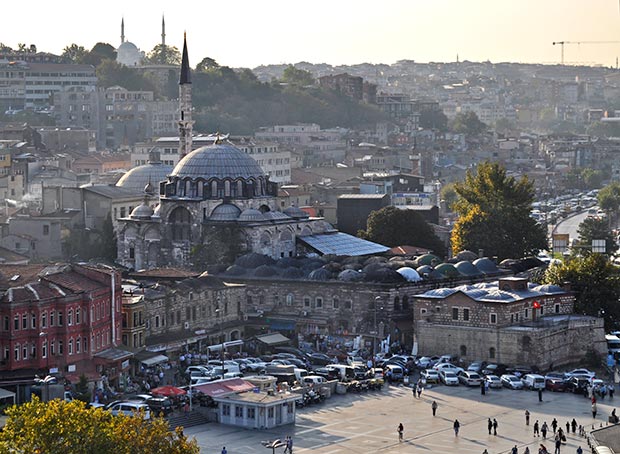
ART HISTORY The Architectural Legacy by Bosniaks in Istanbul
May 19, 2023 FEATURE, Architecture
Bosniaks, besides the Basques in Spain, are the oldest European people, as their ancestors have been continuous residents in this location, since the period of the last ice age. Unlike the dominant Slavic neighbourhood, Bosniaks are mostly of Illyrian, Gothic, and Celtic origin, and to a lesser extent Slavic. Bosniaks, also the youngest Muslims, embraced Islam in the 15th century when the Ottomans arrived in the Balkans. Before that, Bosniaks were Christians, to be more precise, the members of the Bosnian Church, which was a special direction inside the Catholicity, often in conflict with the Vatican.
Between the 12th and 15th centuries, the Bosnian kingdom was governed by powerful Bosniak royal families that dominated Balkans politically and militarily. In the first half of the 15th century, Bosnia was under increasing religious and political pressure from Europe. That was the time of the political crisis and dissatisfaction. During that period, Bosniaks embraced Islam and become citizens of the Ottoman Empire. Islam was at first embraced by the nobility, which later lead to the acceptance of Islam by the lower social classes.
In the 15th century, Bosniaks became a vital part of the Ottoman Empire in all social activities, including religion and culture. Many nobles become the sons-in-law of sultans. Some of the most famous Ottoman Grand Viziers were Bosniaks:
A large list of Bosniaks were prominent military commanders, admirals, viziers, pashas, scholars, and artists. Many left behind numerous monuments like mosques, madrasas, hammams, bezistans, residential facilities, bridges, etc.
It was built in 1496, by the Grand vizier Gazi Ali Pasha who held that position at the time of Sultan Bayezid II. Ali Pasha was born in Sarajevo and educated in Istanbul. He distinguished himself as a very successful general and a man of confidence, which made him the tutor of prince Abdullah. Before he was the Grand vizier (1501-1504 and 1506-1511), he held several important positions. He was murdered in 1511, during the political conspiracy, and buried in the Mosque's graveyard.
One of the oldest monumental mosques in Istanbul is the Atik Ali Pasha Mosque. The complex includes the madrasa, the imaret, the haniqah, and the elementary school. It is located near the Kapali Bazaar, close to Constantine's column. Designed in the early Istanbul style, the Mosque has a central dome with a semi-dome above, the mihrab, and the side chambers vaulted by two smaller domes. Unfortunately, the architect of this monument remains unknown.
 Atik Ali Pasha Mosque / Photo © Islamic Arts Magazine
Atik Ali Pasha Mosque / Photo © Islamic Arts Magazine
 Atik Ali Pasha Mosque, interior / Photo © Islamic Arts Magazine
Atik Ali Pasha Mosque, interior / Photo © Islamic Arts Magazine
The Grand vizier Rustem Pasha was one of the most important persons in the Ottoman Empire. He was born in Sarajevo, between the end of the 15th century and the beginning of the 16th century. Educated in Istanbul, he gradually progressed in his career. He was the Grand vizier of Sultan Suleyman I and was also married to his daughter, the princess Mihrimah. Besides being a good administrator, he is also known as an art lover and an art collector.
The Rustem Pasha Mosque was built in 1562, after his death, by the famous architect Mimar Sinan. The Mosque is well known for its amazing Iznik tiles that ornate almost the entire interior.
 The Rustem Pasha Mosque / Photo © Islamic Arts Magazine
The Rustem Pasha Mosque / Photo © Islamic Arts Magazine
 The Rustem Pasha Mosque, interior / Photo © Islamic Arts Magazine
The Rustem Pasha Mosque, interior / Photo © Islamic Arts Magazine
Sinan Pasha was an admiral of the Ottoman fleet, between 1550 and 1554. Born in Mostar or Sarajevo, he was also Rustem Pasha's brother. In 1555, the Sinan Pasha Mosque was built by the architect Mimar Sinan. Located in the district of Besiktas, the mosque is near the tomb of Hajrudin Barbarossa. The madrasa and the hammam were constructed close to it, but unfortunately, they do not exist anymore. Mimar Sinan, in his design, was inspired by the Uc Serefeli Mosque from the 15th century.
 The Sinan Pasha Mosque / Photo © Islamic Arts Magazine
The Sinan Pasha Mosque / Photo © Islamic Arts Magazine
 The Sinan Pasha Mosque, interior / Photo © Islamic Arts Magazine
The Sinan Pasha Mosque, interior / Photo © Islamic Arts Magazine
Mehmed Pasha Sokolovic was the most famous Grand vizier in the history of the Ottoman Empire. Born at the beginning of the 16th century, in the East part of Bosnia, he was the Grand vizier of three sultans: Suleiman I, Selim II, and Murat III. During that time, it was mostly his merit that the Ottoman Empire reached its expansion and political peak. He was married to the daughter of Sultan Selim II and was assassinated in 1579.
One of his two monumental mosques, the Mehmed Pasha Sokolovic Mosque is located in the district of Kadriga and dates back to 1572. It belongs to Mimar Sinan's best achievements. The interior of the Mosque contains extraordinary Iznik tiles, created in the Hatayi style. The famous Madrasa, which is part of the Mosque's complex, is still in use today.
 The Mehmed Pasha Sokolovic Mosque / Photo © Islamic Arts Magazine
The Mehmed Pasha Sokolovic Mosque / Photo © Islamic Arts Magazine
 The Mehmed Pasha Sokolovic Mosque, interior / Photo © Islamic Arts Magazine
The Mehmed Pasha Sokolovic Mosque, interior / Photo © Islamic Arts Magazine
Comments
Add a comment